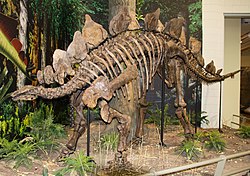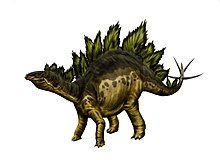Description[edit]
The quadrupedal Stegosaurus is one of the most easily identifiable dinosaur genera, due to the distinctive double row of kite-shaped plates rising vertically along the rounded back and the two pairs of long spikes extending horizontally near the end of the tail. Although large animals at up to 9 m (30 ft) in length,[4] the various species of Stegosaurus were dwarfed by their contemporaries, the giant sauropods. Some form of armor appears to have been necessary, as Stegosaurus species coexisted with large predatory theropod dinosaurs, such as Allosaurus and Ceratosaurus.
The hind feet each had three short toes, while each fore foot had five toes; only the inner two toes had a blunt hoof. The phalangeal formula is 2-2-2-2-1, meaning the innermost finger of the fore limb has two bones, the next has two, etc.[5] All four limbs were supported by pads behind the toes.[6] The fore limbs were much shorter than the stocky hind limbs, which resulted in an unusual posture. The tail appears to have been held well clear of the ground, while the head of Stegosaurus was positioned relatively low down, probably no higher than 1 m (3.3 ft) above the ground.[7]
The long and narrow skull was small in proportion to the body. It had a small antorbital fenestra, the hole between the nose and eye common to most archosaurs, including modern birds, though lost in extant crocodylians. The skull's low position suggests that Stegosaurus may have been a browser of low-growing vegetation. This interpretation is supported by the absence of front teeth and their replacement by a horny beak or rhamphotheca. Stegosaurian teeth were small, triangular, and flat; wear facets show that they did grind their food. The inset placement in the jaws suggests Stegosaurus had cheeks to keep food in their mouths while they chewed.[8]
Despite the animal's overall size, the braincase of Stegosaurus was small, being no larger than that of a dog. A well-preserved Stegosaurus braincase allowed Othniel Charles Marsh to obtain, in the 1880s, a cast of the brain cavity or endocast of the animal, which gave an indication of the brain size. The endocast showed the brain was indeed very small, the smallest proportionally of all dinosaur endocasts then known. The fact that an animal weighing over 4.5 metric tons (5 short tons) could have a brain of no more than 80 g (2.8 oz) contributed to the popular old idea that all dinosaurs were unintelligent, an idea now largely rejected.[9] Actual brain anatomy inStegosaurus is poorly known, but the brain itself was, however, small even for a dinosaur, fitting well with a slow, herbivorous lifestyle and limited behavioural complexity.[10]
Most of the information known about Stegosaurus comes from the remains of mature animals; more recently, though, juvenile remains of Stegosaurus have been found. One subadult specimen, discovered in 1994 in Wyoming, is 4.6 m (15 ft) long and 2 m (6.6 ft) high, and is estimated to have weighed 2.3 metric tons (2.6 t) while alive. It is on display in the University of Wyoming Geological Museum.[11] Even smaller skeletons, 210 cm (6.9 ft) long and 80 cm (2.6 ft) tall at the back, are on display at the Denver M


No comments:
Post a Comment